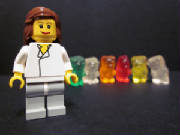
A student of mine (at UIUC), after viewing the Gummy Bear Torture Chamber video making the rounds, asked if a gummy bear would succumb to the forces of high frequency sound waves. My curiosity was piqued so I tested it in the lab. It worked and that was the start of my crusade to use gummy bears to explain scientific concepts and how we do science.
Below each video are a few notes about concepts presented within as well as the materials used.
Looking for more ways to obliterate gummy bears in scientific ways, Joanne freezes a gummy bear in liquid nitrogen. She also soaked a gummy bear over night to demonstrate the ability of gelatin to hold large amounts of water–and then she freezes that one too.
Sonicating a Gummy Bear
In response to all those videos destroying gummy bears in the most scientific manners, Joanne responds by liquefying a gummy bear with high frequency sound waves. Scientists do indeed use this technique to essentially liquefy cells (takes a lot less time) in order to study the contents for forensic or research purposes.
Digesting Gummy Bears with Trypsin
Joanne demonstrates and describes the function of the protease, trypsin’s role in digestion. She also demonstrates that trypsin at physiological temperature works better than cold trypsin.
Gummy Bears Demonstrate Osmosis and Crystallization
In an attempt to alter a gummy bear to make it more conductive to electricity, Joanne instead finds a fun way to demonstrate the scientific concepts of osmosis and crystallization! Accidents in science are sometimes a good surprise!
Determining the Density of a Gummy Bear
Joanne creates a density gradient column inspired by the one in Steve Spangler’s new book Naked Eggs and Flying Potatoes to demonstrate the process of determining the density of irregular objects. First she calculates the density (or specific gravity) of a gummi bear from the known weight in grams divided by the volume in milliliters (or centimeters cubed), and then checks to see where in the column the gummi bear comes to rest.
Joanne also describes how scientists use density columns to separate out objects of different densities such as organelles and blood cells.
A special thanks is due to photographer Jenice Johnson for her gummi bear photo. You can see more at http://www.artsbyjphotog.com
Carbon based "gummy" form meets Molten Potassium Chlorate
Joanne, having not destroyed many gummy bears in the name of science lately, enlisted the help and the lab of Dan Reid, chemistry teacher extraordinaire at Champaign Central High School to destroy a few gummy bears in molten potassium chlorate (not potassium perchlorate, which is used in rocket fuel).
We run through the experiment twice. The orange gummy bear started reacting slowly but rewarded us with a little plume of fire from the test-tube. The red gummy bear happily reacted quite vigorously, but only after you watch Mr. Reid melt the potassium chlorate and hear how he makes fireworks for his class!
Light Absorption and Reflection
This is not Joanne’s video, but one created by The Center for Biophotonics, Science and Technology (CBST) at UCSD.
Using gummy bears you can explore the absorption and reflection properties of materials.
http://www.cbst.ucdavis.edu







